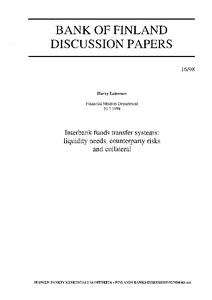Interbank funds transfer systems : Liquidity needs, counterparty risks and collateral
Leinonen, Harry (31.07.1998)
Numero
16/1998Julkaisija
Suomen Pankki
1998
Julkaisun pysyvä osoite on
https://urn.fi/URN:NBN:fi:bof-20140807390Tiivistelmä
Over the next few years, we will see a pronounced increase in the speed at which payment transactions are executed and in the share of cross-border transactions, particularly in the euro area. Counterparty risks and liquidity needs connected with the transfer of funds continue to evolve and to provoke discussion.The fact that funds transfers occur and systems operate on a real-time and gross basis will significantly alter the operational character and technical solutions in this field.Systems following a daily timetable are being replaced by continuously operating systems, which will have a significant impact on banks' liquidity management.The trend toward immediate real-time payment transactions seems inevitable in the light of present trends. It is generally presumed that RTGS systems operating on a gross basis require more liquidity than netting systems.Liquidity needs depend on payment system structures and payment flows.An even flow of payments requires less liquidity than an uneven flow.Liquidity needs can be significantly reduced by choosing an appropriate pa yment system structure, taking measures to even out payment flows and agreeing on market practices.The pricing, collateral and reserve requirement policies of the central bank affect also the efficiency of alternative payment systems.Thus the overall efficiency of a gross or net system depends on many factors. Factors arguing for a gross system are differences in counterparty risks, lack of reciprocity, steady interday payment flows and stable liquidity needs, both within and between days.Factors favouring net systems are the existence of small and varying counterparty risks and structurally unsteady payment flows that result in large interday variations in liquidity, even though overnight variations may be moderate. Current, daily-oriented practices have focused on overnight liquidity needs.In a continuously operating enviroment, liquidity needs are continuously monitored across time-period borders.This means that banks' liquidity management will in the future operate under a new and broader time perspective. Significant liquidity needs and large counterparty risks are inherent parts of Finland's present funds-transfer solutions. Liquidity can be freed for other uses and counterparty risks reduced by changing the structures.The necessary changes have been agreed and soon we will see fundamental changes in Finnish payment systems. Key word: payment system settlement, gross settlement, RTGS, payment system counterparty risks, payment system liquidity needs
